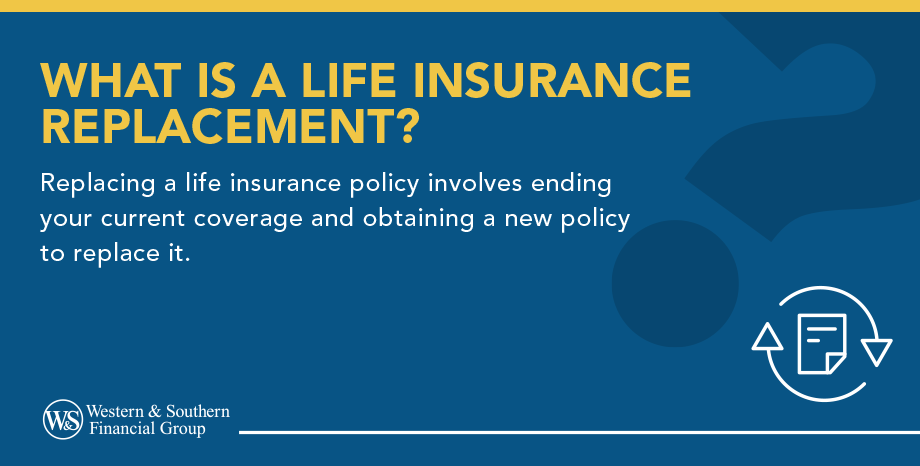Table of Contents
Table of Contents


Key Takeaways
- Life insurance replacement involves swapping your current policy for a new one to get better coverage or lower premiums.
- Reasons for replacement can include changing financial needs, improved health, or better features in a new policy.
- Replacing life insurance can have potential drawbacks, such as surrender charges, new contestability periods, and the loss of existing benefits.
- Regulations exist to help protect consumers, including disclosure requirements, side-by-side comparisons, and a free-look period.
- It's recommended that you consult with an experienced life insurance agent to weigh the benefits and risks of replacing your policy.
What Does Replacing Life Insurance Mean?
Replacing a life insurance policy means canceling your existing coverage and helping secure a new policy for reasons like better rates, different coverage, or changing needs.
Replacing life insurance is not the same as simply adding another policy. Replacing a policy cancels a person's original coverage as the new replacement policy takes its place.
Reasons to Consider Replacing Your Life Insurance Policy
Reasons to consider replacing your current life insurance policy include:
Lower Premiums
A common reason to replace a life insurance policy is to lower premium costs. As life insurance companies adjust their rates and introduce new products, you may find an opportunity to save money and reduce your expenses.
More Coverage or Additional Benefits
Another reason to consider replacing your life insurance policy is the need for increased coverage or additional features. As your finances change, you might need a larger death benefit to help protect your family adequately.
Alternatively, newer policies might come with better riders, such as accelerated death benefits, long-term care coverage, or a premium waiver unavailable when you purchased your original policy.
Change in Financial Circumstances
A significant life event, such as the birth of a child, buying a home, or even nearing retirement, could change your financial needs. You might want more coverage to help secure your growing family's future or to pay off large debts like a mortgage in the event of your death.
Switching From Term to Permanent Coverage
If you initially purchased a term life insurance policy because it was more affordable but now want lifelong protection, you might replace your term policy with a permanent life insurance policy. Whole life or universal life policies offer cash value accumulation and a lifetime death benefit, which may be attractive if your financial needs have changed.
Improved Health
Your health status plays a significant role in life insurance premiums. You may qualify for lower rates if you've significantly improved your health by quitting smoking, losing weight, or managing a chronic condition since purchasing your policy.
Potential Pitfalls of Replacing Life Insurance
Though there are valid reasons to replace life insurance policies, it's necessary to be aware of the potential risks before making the decision.
New Contestability Period
When you replace your life insurance policy, a new contestability period, usually two years, begins, allowing the insurer to review your application and deny claims if misrepresentation is found. Any misstatements during the new policy’s contestable period could result in claim denial.
Higher Premiums Due to Age
When you replace an old policy with a new one, you are applying at your current age, which means premiums may be higher, resulting in a cost increase. Depending on your age, this could outweigh any benefits you expect from switching policies.
Loss of Existing Benefits
Older life insurance policies may include features no longer available in newer plans. You could lose valuable riders or benefits when replacing your policy.
Cash Value Loss
Consider the cash value accumulation if replacing a permanent life insurance policy. Cash value can take many years to grow, and you may start over by replacing your policy could be significantly affected by the timing and frequency of withdrawals or loans. Keep an eye out for income tax impacts.
Surrender Charges
Permanent policies often incur surrender fees if canceled within a certain surrender period. Switching policies might also incur surrender charges, which could potentially outweigh the advantages of a new policy.
Replacement Regulations
When replacing a life insurance policy, be mindful of the state insurance department regulations that govern such replacements.
Each state in the U.S. has its own rules and requirements, often based on model regulations developed by the National Association of Insurance Commissioners (NAIC). The NAIC model regulation also applies to annuity contracts.1
The NAIC offers guidelines and model acts to help ensure state consistency, but individual state regulators may modify or expand these regulations.
Regulatory oversight helps protect consumers by helping ensure they receive proper disclosures and are informed of the risks of replacing life insurance policies.
Disclosure Requirements
Insurance companies and agents must provide specific disclosures when a policy replacement is considered. These disclosures help ensure you understand the differences between your existing policy and the new one, including potential drawbacks like higher premiums, new contestability periods, and loss of benefits. The goal is to help ensure you are fully informed before making a decision.
Comparison Forms
In many states, insurance agents must offer a side-by-side comparison of existing and proposed policies, detailing premiums, coverage amounts, dividends, riders, clauses and exclusions, and cash value implications. Reviewing this comparison, you can better understand how the new policy stacks up against your current coverage.
Free-Look Period
Most states require a "free-look period" for new life insurance policies. This period typically lasts 10 to 30 days, during which you can review the new policy and cancel it for a full refund if you decide that replacing your old policy was not the right decision. This regulation is in place to allow consumers to reconsider their decision without financial penalty. This period applies only to new policies and that it offers the chance for a full refund without penalty.
Agent Responsibilities
Insurance agents must prioritize your best interest by ensuring that any recommended policy replacements are appropriate for your specific situation. Agents are required to provide disclosures about the potential risks and benefits of policy replacement.
Agents are required to document the reasons for recommending a replacement, and you may be asked to sign a form acknowledging that you understand the potential risks and benefits of the replacement. Agents must act in the best interest of the client, ensuring that all material facts about the replacement are disclosed, including financial consequences like surrender charges and tax liabilities.
When Replacing Life Insurance Makes Sense
Replacing a life insurance policy can be beneficial in certain situations. Here are some instances where a replacement makes sense:
- Term Policy Expiration: If your term life policy is expiring and you still need coverage, replacing it with another term or permanent policy is a logical step to maintain your family’s protection.
- Better Rates Are Available: Replacing your existing policy can lead to significant cost savings if you qualify for better rates due to improved health or lower market rates.
- Evolving Needs: Life events such as getting married, having children, or buying a house may necessitate a different type or amount of coverage. Replacing your policy can help you align your insurance with your current needs.
Steps to Replace Your Life Insurance Policy Wisely
If you’ve decided that replacing your life insurance coverage is the right move, follow these steps to make a well-informed decision:
1. Evaluate Your Current Policy
Before making any changes, take a detailed look at your current policy. Understand the death benefit, premium, riders, and any cash value that has built up. This will help you determine whether the new policy is genuinely a better fit for your needs.
2. Shop Around for Quotes
Get quotes from multiple life insurers to compare rates and coverage options. Different companies may offer different pricing, even for the same level of coverage, based on factors like your age, health, and lifestyle.
3. Understand the New Policy
Ensure you understand the new policy's terms, including any riders, the length of the contestability period, and premium payment requirements. If you’re switching from a term policy to a permanent one, ask how the cash value accumulation works.
4. Don’t Cancel Your Old Policy Immediately
Your existing policy should remain in force until the new policy is issued and active, so you are not left without coverage during the transition. Only cancel the old policy once you have confirmed that your new policy is in force and meets your expectations.
5. Consult a Financial Professional
An experienced life insurance agent can help you understand whether replacing your policy makes financial sense. They can help you consider all the factors and navigate the application process to avoid pitfalls.
Alternatives to Replacing Your Life Insurance Policy
If replacing your policy feels like a drastic move, some alternatives might better suit your needs:
- Policy Conversion: If you have a term policy and want permanent coverage, your current insurer may allow you to convert your term policy to a permanent one without a new medical exam. This can be a more convenient option than replacing your policy.
- Add Riders: Consider adding riders to expand coverage instead of replacing your policy. Riders like critical illness, long-term care, or accidental death benefit riders can enhance your coverage.
- Layering Policies: You could keep your current policy and add a new one for additional coverage. This is known as “layering” policies and can provide more comprehensive coverage without the drawbacks of canceling your existing policy.
Conclusion
Replacing your life insurance policy is a significant financial decision with lasting consequences. By carefully considering your needs and financial situation, understanding the potential drawbacks, and following the proper procedures, you can make an informed choice that helps protect your loved ones and your financial future.
Compare life insurance policies today and see how much you could save! Get a Free Life Insurance Quote
Frequently Asked Questions
What is the replacement rule for life insurance?
The replacement rule for life insurance mandates that insurers and agents provide detailed disclosures when a policyholder considers replacing an existing policy with a new one.
This includes comparing the existing and new policies side-by-side to help ensure that the customer understands the benefits and potential downsides, such as higher premiums or loss of benefits.
These regulations are in place to help protect consumers from unnecessary or detrimental replacements by helping ensure transparency and informed decision-making.
What is churning life insurance?
Churning in life insurance refers to the unethical practice where an agent encourages a policyholder to replace an existing policy with a new one to generate additional commissions, often without any significant benefit to the policy owner.
This often leads to increased premiums, loss of accumulated benefits, and a new contestability period. It’s generally against the policyholder's best interests and can result in financial harm.
What is Florida's definition of life insurance replacement?
Florida regulation 69O-151.002 Definition of Replacement states:
"Replacement means any transaction in which new life insurance is to be purchased, and it is known or should be known or to the proposing insurer that by reason of such transaction existing life insurance has been or is to be:
(1) Lapsed, forfeited, surrendered, or otherwise terminated;
(2) Converted to reduced paid-up insurance, continued as extended term insurance, or otherwise reduced in value by the use of nonforfeiture benefits or other policy values;
(3) Amended so as to effect either a reduction in benefits or in the term for which coverage would otherwise remain in force or for which benefits would be paid;
(4) Reissued with any reduction in cash value; or
(5) Pledged as collateral or subjected to borrowing, whether in a single loan or under a schedule of borrowing over a period of time, for amounts in aggregate exceeding twenty-five (25%) of the loan value set forth in the policy."
Sources & Footnotes
- LIFE INSURANCE AND ANNUITIES REPLACEMENT MODEL REGULATION - National Association of Insurance Commissioners (NAIC). https://content.naic.org/sites/default/files/inline-files/MDL-613.pdf
- REQUIREMENTS FOR REPLACEMENT OF LIFE AND HEALTH COVERAGE - Florida Department of State. https://www.flrules.org/gateway/chapterhome.asp?chapter=69o-151

















































